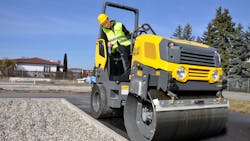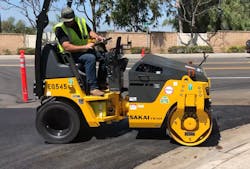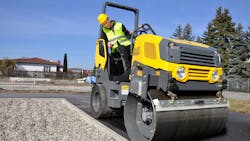Combination rollers provide versatile asphalt compaction
The moniker aptly describes the machine: combination roller. Take a double drum vibratory compactor, swap out the rear drum for an axle carrying four tires, and a manufacturer can field a machine that combines the heavy compaction of a steel drum with the finish capabilities of pneumatic tires. The one machine can potentially function as two, eliminating the need for a second compactor and the accompanying transportation and project costs.
Mat type and application determine performance specifications for the combi roller. The criteria are similar to those used to specify a double-drum compactor: Performance specifications—such as weight, rolling width, vibration frequency, amplitude, and total centrifugal force—must satisfy the applications for which the combi is used.
Applications range from small asphalt jobs to larger pavements potentially funded by federal money flowing into states via the Infrastructure Investment and Jobs Act (IIJA). In order to take advantage of this funding, equipment managers need to be attuned to state requirements for asphalt paving projects.
“I would start looking at what the state specifications allow them to do, [to determine] if there is any kind of minimum requirements that they need to meet,” says Tim Kowalski, application support manager for Hamm. “Some states require rubber-tired rollers, but they don’t state what size or how many wheels that a combination roller [must have].”
Brad Belvin, manager—sales and marketing for Sakai, concurs.
Keep abreast of state pavement specs
“The advice I would have for an equipment manager is to have some form of relationship, especially with the local state agencies [and] with paving associations, to see what changes are coming down the pipeline,” he says.
Another project parameter to consider is material and application. The properties of the asphalt itself affect whether rubber tires can be used. High temperatures, polymer modifieds, or rubber modifieds are some properties that can cause problems for rubber tires. A release agent will help in those situations, so manages may spec a separate tank mounted on the rear to hold a release agent or use a water tank to blend release agents in various ratios.
Rubber tires also provide traction for projects that include steep grades. The combi, with its four driving rubber tires, provides more tractive effort than does a steel drum. Where traction and gradeability are important, the combi performs better than a double-drum vibratory roller. The rubber tires also allow fleets to load the roller onto a trailer using a ramp rather than requiring a lift to place the roller onto the trailer deck.
Brian Nagel, sales support consultant for Caterpillar, says combis are growing in popularity.
“Contractors like the smooth finish that combi rollers leave behind and are starting to use them to differentiate themselves against their competition,” he says. “It’s an easy way to set their work apart from the others and deliver a premium, high-quality product.”
Operator preference and experience also contribute to effective use of combination rollers. As a niche product without broad market penetration, the machine enjoys popularity in some parts of the country and less in others. Belvin says it is not uncommon for a migrating operator to bring his preference into their new region.
“They bring them in, and they love it,” he says. “It’s sometimes market acceptance. When Joe Snow has one, it’s ‘Man, I got to have one.’”
Operator familiarity enables efficiency in the use of a combi, Belvin says.
What is the cost of ownership for a combination roller
“For an equipment manager, that’s going to be probably one of your key metrics: What’s my utilization? How am I getting the money out of this capital good?” he says. “So obviously having an operator that’s familiar with that is going to solve a lot of that problem. For unfamiliar operators, the first time they go on they don’t know how to use the emulsion properly, and you start picking up. The second you start having problems on a site, people get real jumpy real fast.”
Of course, the combi’s niche benefits play into the equipment manager’s deployment decisions, too. Combination rollers, with a steel front drum for and pneumatic tires on the rear, provide two types of compaction in one machine. Utilization increases when one machine can replace two. Project operating costs go down as one machine works without a second unit sitting idle, and less transportation is required to move multiple units, according to Jeremy Dulak, Case Construction Equipment product manager compaction and dozers.
“It provides the compaction power of the steel vibratory roller in the front, with the finish ability of the pneumatic tires,” Dulak says. “Those tires are kneading that asphalt, which results in excellent density, fewer voids, and that well-sealed finish. If you’re just hitting it, you’re going to compact it, but you are not going to reach the same surface quality which may potentially lead to more repairs in the future.”
Volvo Construction Equipment’s Mark Eckert, product manager—compactors and Compact Assist, describes the combi as “versatile.”
“Obviously a vibratory roller gives you vibratory compaction,” he says. “A combination roller with the rubber tires gives you pneumatic compaction…without having to purchase a separate machine.”
Combi operation ensures mat quality, says Hamm’s Kowalski.
“You can run the steel drum upfront as a breakdown [compactor], then you have the rubber tires in the back kneading that material. Then turn the combination roller around with the rubber tires up front, and finish with the steel to take out the tire mark. The combination roller might help you reduce the roller fleet, maybe by one roller.”
Luke Sevcik, production application and training specialist for Wacker Neuson, concurs.
“Over-vibration on cooler asphalt can damage the bed or even break aggregate causing localized loss of binder to aggregate,” he says. “The rear tires help seal up the surface and has little to no effect of adjacent pavement being it new or existing.”
Sakai’s Belvin counters the idea that combinations are primarily a small- or medium-sized fleet purchase.
“Anywhere you can use a double drum—3- or a 5-ton roller—there’s no reason that you can’t use a combi roller in its place,” he says. “We’ll find certain contractors that will have large fleets, running main line paving, but they’ll also have a whole fleet of combi rollers to go with.”
Contractors that pave multiple large jobs such as highways will have both double-drum vibratory rollers and pneumatic-tired rollers for mainline paving. But even these fleets can leave combis on a job when they move the mainline paving train to another project. Combination rollers can finish around manhole covers or similar areas where large double drums cannot maneuver or where smaller sections of asphalt pavement do not require two compactors.
Combination rollers give asphalt contractors flexibility, too, says Nagel.
“Having one machine not only cuts down on cost, but also gives contractors the flexibility for different jobs day to day,” he says. “Because of the flexibility that a combi roller provides with a drum and tires, one machine can be used for multiple applications.
“Crews that do patch work really like the ability to press joints with the tires to ensure good compaction as well as have a drum with vibration to get a smooth finish,” Nagel says. “For crews doing high-end driveway and parking lot work, the combi machine provides good compaction with the vibrating drum, and the kneading action of the tires creates a tight finish.”
Although combis do not have the market penetration of other rollers, they are popular with government fleets, says Kowalski.
“You would be surprised,” he says. “There are actually more municipalities [and] counties that do their own paving work because they can get two rollers in one. If they’re doing their own work, they like them a lot. That’s a huge savings for them, if they only have to buy one machine versus two.”
How to determine combination roller lifecycle
Because the design of a combination roller is similar to that of a double-drum vibratory roller, its lifespan generally mirrors the double-drum. Well-maintained combis can last decades, allowing fleet managers to bank on a total cost of ownership similar to the double-drum. Combinations also find second lives through the used equipment market. Even tires will provide long life if properly maintained and if the machine is used properly.
Most combination rollers use a separate tank and spray system for release agents, in addition to the steel drum’s water spray system, to keep tires from sticking to the asphalt they are compacting. If emulsions are used properly, tires will perform, and specialized asphalt mixes will require more attention to the amount and frequency of the release agent use. Diesel fuel, an old-school release agent, should never be used. Diesel degrades not only the tires, but also the mat itself.
Warm tires also perform better. When at the right temperature, tires may not require the release agent, and tire skirts will help retain the heat.
“You have to get those tires warmed up,” says Kowalski. “The more heat you can get in those tires before you get on the mat the less release agent you’re going to use on the tires, and the better success you’re going to have.”
If or when tires need to be replaced, replace them with tires from the same tire maker.
“There are different manufacturers of tires, even though they might be the same size,” Kowalski says. “They have different types of rubber that they use [and] different sidewall thicknesses. Every tire manufacturer has a tire pressure chart that sets up the specific pressure based on the weight of the machine to get the right contact area for that tire to do the proper kneading effect of it.”
Fleet managers should also consider machine technology advancements. Intelligent compaction functionality that is available on more traditional rollers can usually be implemented with combis. For asphalt work regulated by state agencies or performance specifications, such technology will help operators produce the optimal final finish.
Although widely popular in Japan, the universe of combination rollers is small compared to other types of rollers in the United States. In fact, a substantial portion of new-machine sales are into dealer rental fleets. Renting provides contractors with the latest technology, which can improve productivity.
Utilization and owning costs should drive the rental decision, says Steve Brown, general rental manager for Louisiana Cat.
“Deferring risk of ownership is a key benefit, especially in a high interest rate environment,” he says. “The rental company ensures uptime by immediately exchanging any down equipment and takes on their own maintenance and other ownership expenses.”
Sakai’s Belvin says that rental is worth considering if utilization is low.
“I don't see any detriment to having one in your fleet if you’re going to use it,” he says. “You’re not going to be having a lot different TCO costs between the two machines.”
Current economic conditions pose challenges to rental decision, too, Belvin says.
“Everybody's running backlogs, ourselves included,” he says. “Supply chain [issues] will make it a little bit more difficult this time for anyone looking at rental versus purchase. If you have a good dealer who has good OEM partner support, and [they] can keep them up and running, that can help.”
The niche nature of combinations also creates an environment for rental, depending on a project’s compaction requirements, according to Case’s Dulak.
“A contractor may have multiple projects, as well as a mix of projects, so his total needs for compaction units are going to vary,” he says. “Renting allows that contractor to have flexibility in their fleet…and allows them to minimize machines from being underutilized. But if a contractor knows they’ll be heavily using that machine, that’s when you want to be buying.”
Rental may diminish operator efficiency, cautions Hamm’s Kowalski.
“If you buy it,” he says, “[operators] get…comfortable with using [it]. If you keep changing them in for new rentals, they might change the operator station, and then you have to retrain how to run them and operate them.”
About the Author
Rod Sutton
Sutton has served as the editorial lead of Construction Equipment magazine and ConstructionEquipment.com since 2001.
Our mission is to help managers of heavy equipment and trucks to improve their performance in acquiring and managing their fleets. One way we do that is with our Executive Institute, where experts share information and ideas that will enable equipment managers to accurately manage equipment costs so that they can deliver the optimum financial benefits to their organizations.
We also have a laser focus on product development, performance, and technology; as well as equipment acquisition, disposal, and maintenance. Our exclusive Field Tests take earthmoving equipment and truck into the field for professional evaluations.
Check out our free newsletters to see the latest content.
You can find Sutton on LinkedIn.




